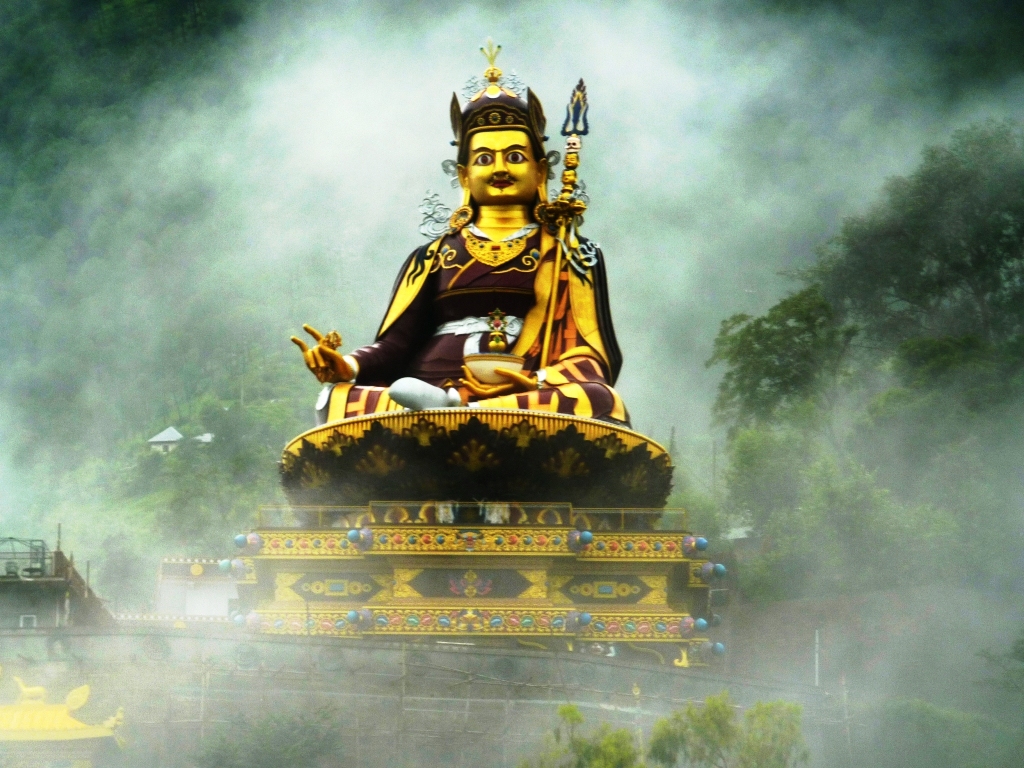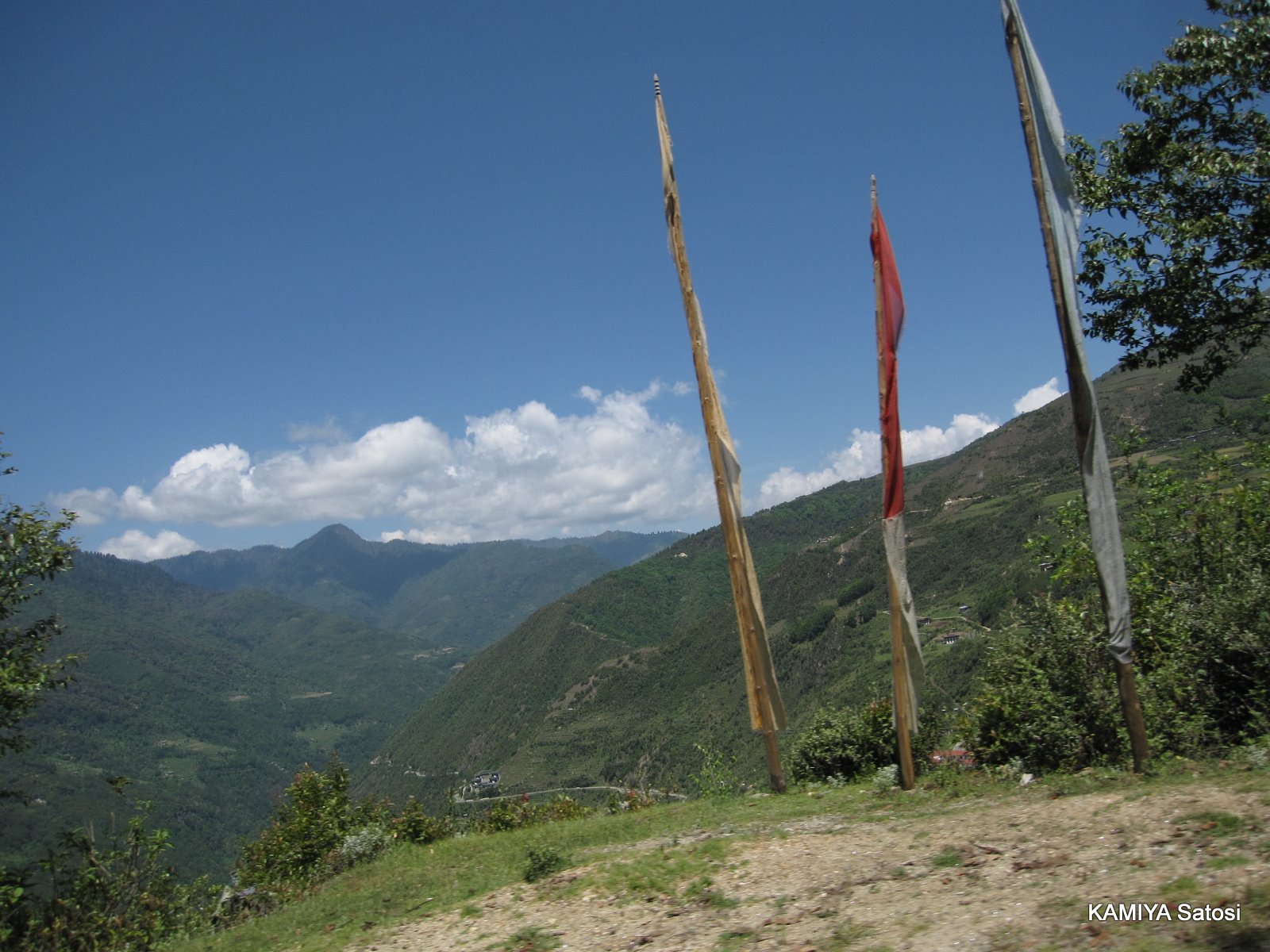|
Tsechu
A tshechu (, literally "tenth day") is any of the annual religious Bhutanese festivals held in each district or dzongkhag of Bhutan on the tenth day of a month of the lunar Tibetan calendar. The month depends on the place. Tshechus are religious festivals of the Drukpa Lineage of the Kagyu school of Tibetan Buddhism. Tshechus are large social gatherings, which perform the function of social bonding among people of remote and spread-out villages. Large markets also congregate at the fair locations, leading to brisk commerce.Dancing on the demon's back: the dramnyen dance and song of Bhutan by Elaine Dobson, John Blacking Symposium: Music Culture and Society, Callaway Centre, University of Western Australia, July 2003 The |
Thongdrel
A thongdrel (མཐོང་གྲོལ།) or throngdrel is a large appliqué (གོས་དྲུབ།) religious image normally only unveiled during '' tsechus(ཚེ་བཅུ།)'', the main religious festivals in Bhutan. They are the largest form of '' thangka(ཐང་ཀ།)'' paintings in the tradition of Tibetan Buddhism. Thongdrels typically depict a seated Guru Rinpoche surrounded by holy beings in a composition that, unlike most smaller thangkas, is in a "landscape" format, somewhat wider than it is tall. Thongdrels are composed of several layers, mostly of silk. These begin with a backing, then the image itself, made up of appliqué pieces sewn to a background. Finally there is a yellow drape that covers and protects it when not on display. Thongdrels are stored rolled up. Thongdrels are displayed once a year as the highlight of the tsechu festival of a district or ''dzongkhag'' (although not every district has a thongdrel). Typically they are displayed ... [...More Info...] [...Related Items...] OR: [Wikipedia] [Google] [Baidu] |
Thimphu
Thimphu (; ) is the capital and largest city of Bhutan. It is situated in the western central part of Bhutan, and the surrounding valley is one of Bhutan's '' dzongkhags'', the Thimphu District. The ancient capital city of Punakha was replaced by Thimphu as the capital in 1955, and in 1961 Thimphu was officially declared the capital of the Kingdom of Bhutan by the 3rd Druk Gyalpo Jigme Dorji Wangchuck. The city extends in a north–south direction on the west bank of the valley formed by the Wang Chhu, which flows out into India as the Raidāk River. Thimphu is the sixth highest capital in the world by altitude, ranging from to . Unlike many capitals, Thimphu does not have its own airport, instead relying on the Paro Airport, accessible by road away. Thimphu, as the political and economic center of Bhutan, has a dominant agriculture and livestock base, contributing to about 45% of the country's GNP. Tourism, though a contributor to the economy, is strictly regulated, ... [...More Info...] [...Related Items...] OR: [Wikipedia] [Google] [Baidu] |
Bhutan
Bhutan, officially the Kingdom of Bhutan, is a landlocked country in South Asia, in the Eastern Himalayas between China to the north and northwest and India to the south and southeast. With a population of over 727,145 and a territory of , Bhutan ranks List of countries and dependencies by area, 133rd in land area and List of countries and dependencies by population, 160th in population. Bhutan is a Democracy, democratic constitutional monarchy with a King of Bhutan, King as the head of state and a Prime Minister of Bhutan, prime minister as the head of government. The Je Khenpo is the head of the state religion, Vajrayana Buddhism. The Himalayas, Himalayan mountains in the north rise from the country's lush subtropical plains in the south. In the Mountains of Bhutan, Bhutanese Himalayas, there are peaks higher than above sea level. Gangkhar Puensum is Bhutan's highest peak and is the highest unclimbed mountain in the world. The wildlife of Bhutan is notable for its diversi ... [...More Info...] [...Related Items...] OR: [Wikipedia] [Google] [Baidu] |
Dance Of The Black Hats With Drums, Paro Tsechu 4
Dance is an art form, consisting of sequences of body movements with aesthetic and often symbolic value, either improvised or purposefully selected. Dance can be categorized and described by its choreography, by its repertoire of movements or by its historical period or place of origin. Dance is typically performed with musical accompaniment, and sometimes with the dancer simultaneously using a musical instrument themselves. Two common types of group dance are theatrical and participatory dance. Both types of dance may have special functions, whether social, ceremonial, competitive, erotic, martial, sacred or liturgical. Dance is not solely restricted to performance, as dance is used as a form of exercise and occasionally training for other sports and activities. Dance performances and dancing competitions are found across the world exhibiting various different styles and standards. Dance may also be participated in alone as a form of exercise or self expression. Dancing is ... [...More Info...] [...Related Items...] OR: [Wikipedia] [Google] [Baidu] |
Padmasambhava
Padmasambhava ('Born from a Lotus'), also known as Guru Rinpoche ('Precious Guru'), was a legendary tantric Buddhist Vajracharya, Vajra master from Oddiyana. who fully revealed the Vajrayana in Tibet, circa 8th – 9th centuries... He is considered an emanation or Nirmāṇakāya of Gautama Buddha, Shakyamuni Buddha as foretold by the Buddha himself. According to early Tibetan sources including the ''Testament of Ba'', he came to Tibet in the 8th century and designed Samye Monastery, the first Buddhist monastery in Tibet during the reign of King Trisong Detsen. He, the king, and Khenpo Shantarakshita are also responsible for creating the Tibetan canon, Tibetan Canon through translating all of the Buddha's teachings and their commentaries into the Tibetan language. According to Lewis Doney, while his historical authenticity was questioned by earlier Tibetology, Tibetologists, it is now "cautiously accepted.” Padmasambhava himself was recorded as saying he was an historical per ... [...More Info...] [...Related Items...] OR: [Wikipedia] [Google] [Baidu] |
Lhuntse District
Lhuentse District (Dzongkha: ལྷུན་རྩེ་རྫོང་ཁག་; Wylie transliteration, Wylie: ''Lhun-rtse rdzong-khag''; previously "Lhuntshi", and officially spelled ''Lhuentse'' ) is one of the 20 dzongkhag (districts) in Bhutan. It consists of 2506 households. Located in the northeast, Lhuentse is one of the least developed dzhongkhags of Bhutan. There are few roads, the first gas station was opened in September 2005, electricity is not well distributed, and the difficult terrain makes distribution of social welfare problematic. Despite its favorable climate, farming is hindered by the lack of infrastructure. Culture Lhuentse is culturally part of eastern Bhutan. The languages of Bhutan, languages and lifestyle of its inhabitants may be contrasted against the dominant western Ngalop culture. This region is renowned as a textiles producing region and as the ancestral homeland of the House of Wangchuck, Bhutanese royal family. It is also well known for the domes ... [...More Info...] [...Related Items...] OR: [Wikipedia] [Google] [Baidu] |
Trongsa District
Trongsa District (Dzongkha: ཀྲོང་གསར་རྫོང་ཁག་; Wylie transliteration: ''Krong-gsar rdzong-khag'') is one of the districts of Bhutan. It is the most central district of Bhutan and the geographic centre of Bhutan is located within it at Trongsa Dzong. Languages Trongsa is a linguistically diverse district. In the north and east inhabitants speak Bumthang language, Bumthangkha, and in the extreme southeast Kheng language, Khengkha is spoken. Nyenkha language, Nyenkha is spoken in the western half of the district, straddling the border with Wangdue Phodrang District. To the north, along and across the same border, live speakers of Lakha language, Lakha. In the extreme south, the national language Dzongkha is spoken. Across the mid-south, tiny communities of autochthonous 'Olekha, 'Olekha (Black Mountain Monpa) speakers have all but disappeared. Historically, Bumthangkha and its speakers have had close contact with speakers of Kurtöp language, Kurtöp ... [...More Info...] [...Related Items...] OR: [Wikipedia] [Google] [Baidu] |
Jakar
Jakar () is a town in the central-eastern region of Bhutan. It is the district capital ( dzongkhag thromde) of Bumthang District and the location of Jakar Dzong, the regional dzong fortress. The name Jakar roughly translates as "white bird" in reference to its foundation myth, according to which a roosting white bird signalled the proper and auspicious location to found a monastery around 1549. History The town is the site of Chakhar Lhakhang, a small and unassuming temple which marks the site of the "Iron Palace" of Sindhu Raja, the Indian monarch who is believed to have first invited Guru Rinpoche to Bhutan in 746. The current building is said to have been constructed by Tertön Dorje Lingpa in the 14th century. According to the Jakar foundation myth, a roosting white bird signaled the proper and auspicious location to found a monastery around 1549. The settlement thus earned the moniker Jakar, meaning "white bird." There are many significant Buddhist sacred sites nea ... [...More Info...] [...Related Items...] OR: [Wikipedia] [Google] [Baidu] |
Tamzhing Monastery
Tamzhing Lhündrup Monastery () in Bumthang District in central Bhutan is a Nyingma gompa in Bhutan. Its temple and monastery are remarkable for their direct connection to the Bhutanese tertön and saint, Pema Lingpa (1450-1521) and his tulkus. It is now the seat of Sungtrul Rinpoche, the current speech incarnation of Pema Lingpa. Tamzhing consists of a deteriorating temple and a cramped vihara. It supports a body of over 95 Buddhist monks. In March 2012, the monastery was submitted for inscription on the list of World Heritage Sites; it currently resides on the tentative list. History The temple was built by Pema Lingpa in 1501; the coeval wall paintings include his portrait and are amongst the earliest in the country. Before 1960 Tamshing was a privately owned temple (like many other temples in Bhutan). After Pema Lingpa died in the temple at the age of seventy-two in 1521, his descendants took over care of the temple. Gradually, over many years, Tamshing fell into a stat ... [...More Info...] [...Related Items...] OR: [Wikipedia] [Google] [Baidu] |
Bumthang District
Bumthang District (Dzongkha: བུམ་ཐང་རྫོང་ཁག་; Wylie: ''Bum-thang rzong-khag'') is one of the 20 dzongkhag (districts) comprising Bhutan. It contains numerous temples and Buddhist sacred sites. The district is divided into four '' gewogs'' (village blocks), each corresponding to a major glacial valley: Choekor, Tang, Ura, and Chhume. The latter valley is also called Bumthang, lending its name to the whole district. ''Bumthang'' directly translates as "beautiful field" – ''thang'' means field or flat place, and ''bum'' is said be an abbreviation of either ''bumpa'' (a vessel for holy water, thus describing the shape and nature of the valley), or simply ''bum'' ("girl", indicating this is the valley of beautiful girls). The name is said to have arisen after the construction of Jambay Lhakhang. Economy Bumthang's primary agricultural products are wheat, buckwheat, dairy, honey, apples, potatoes, rice, and wool. Bumthang is also nationally fam ... [...More Info...] [...Related Items...] OR: [Wikipedia] [Google] [Baidu] |
Sindhu Raja
The Indus ( ) is a transboundary river of Asia and a trans-Himalayas, Himalayan river of South Asia, South and Central Asia. The river rises in mountain springs northeast of Mount Kailash in the Western Tibet region of China, flows northwest through the disputed Kashmir region, first through the Indian-administered Ladakh, and then the Pakistani administered Gilgit Baltistan, Quote: "Kashmir, region of the northwestern Indian subcontinent. It is bounded by the Uygur Autonomous Region of Xinjiang to the northeast and the Tibet Autonomous Region to the east (both parts of China), by the Indian states of Himachal Pradesh and Punjab to the south, by Pakistan to the west, and by Afghanistan to the northwest. The northern and western portions are administered by Pakistan and comprise three areas: Azad Kashmir, Gilgit, and Baltistan, ... The southern and southeastern portions constitute the Indian state of Jammu and Kashmir. The Indian- and Pakistani-administered portions are divi ... [...More Info...] [...Related Items...] OR: [Wikipedia] [Google] [Baidu] |






